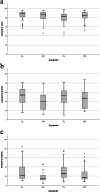Reliability of two different measuring techniques with computer tomography for penetration and distribution of cement in the proximal tibia after total knee arthroplasty
- PMID: 32532306
- PMCID: PMC7291566
- DOI: 10.1186/s12891-020-03390-3
Reliability of two different measuring techniques with computer tomography for penetration and distribution of cement in the proximal tibia after total knee arthroplasty
Abstract
Background: To evaluate the reliability of two different techniques for measuring penetration and distribution of the cement mantle in the proximal tibia after total knee arthroplasty (TKA) with Computer Tomography (CT) in vivo.
Methods: Standardized CT scans of the proximal tibia were taken 1 to 2 years after total knee arthroplasties implanted with a surface cementing technique. These prospectively acquired transversal CT images of the surface of the proximal tibia were divided into four quadrants and were assessed once manually and once with a numerical computing program (MATLAB® Update 2, The MathWorks, Inc.) based on Hounsfield Units by one of the researchers. The assessments were repeated by the same and a second researcher. The ratio cement/trabecular bone was calculated 1, 3 and 5 mm distal of the tibia tray per quadrant. Kruskall-Wallis tests with multiple pairwise comparisons (Dunn's test) were used to determine differences between the quadrants. Intra- and inter-rater reliability as well as the inter method reliability were assessed with the Intraclass Correlation Coefficient (ICC) per level of depth and with Bland-Altman plots.
Results: A total of 92 CT scans were included. The intra- and inter-rater reliability of the manual method ranged from 0.22 and 0.52. The intra- and inter-rater reliability of the matlab method varied between 0.98 to 0.99. The median percentage cement measured with the matlab method 1 mm underneath the tibial tray varied between 82 and 88%; at 3 mm depth between 38 and 54% and at 5 mm between 15 and 25%. There was significantly (p < 0.05) less cement in the antero-medial quadrant compared to the antero-lateral and postero-lateral quadrant at 3 mm and 5 mm depth.
Conclusions: Distribution and penetration of cement in the proximal tibia in a total knee arthroplasty can be measured reliably with CT in combination with the matlab method presented in this manuscript. This method can be used for clinical purposes as well as for scientific research.
Trial registration: METC-nr: 06-104 Dossier NL14807.098.06/versie 06.
Keywords: CT scan; Cement distribution; Cement penetration; Computer tomography; TKA; Total knee Arthroplasty.
Conflict of interest statement
One of the authors (PP) is an employee of Zimmer Biomet, Warsaw, IN, USA, a manufacturer of orthopedic implants.
Figures





Similar articles
-
Validation of a measuring technique with computed tomography for cement penetration into trabecular bone underneath the tibial tray in total knee arthroplasty on a cadaver model.BMC Med Imaging. 2014 Aug 27;14:29. doi: 10.1186/1471-2342-14-29. BMC Med Imaging. 2014. PMID: 25158996 Free PMC article.
-
Accuracy of a non-invasive CT-based measuring technique for cement penetration depth in human tibial UKA.BMC Med Imaging. 2019 Jan 21;19(1):9. doi: 10.1186/s12880-019-0312-x. BMC Med Imaging. 2019. PMID: 30665370 Free PMC article.
-
Intrusion Characteristics of High Viscosity Bone Cements for the Tibial Component of a Total Knee Arthroplasty Using Negative Pressure Intrusion Cementing Technique.Iowa Orthop J. 2016;36:161-6. Iowa Orthop J. 2016. PMID: 27528854 Free PMC article.
-
Cementing technique for primary knee arthroplasty: a scoping review.Acta Orthop. 2019 Dec;90(6):582-589. doi: 10.1080/17453674.2019.1657333. Epub 2019 Aug 27. Acta Orthop. 2019. PMID: 31452416 Free PMC article.
-
Cement Burn of the Skin Following Total Knee Arthroplasty Case Report and Review of the Literature.Bull Hosp Jt Dis (2013). 2023 Jun;81(2):156-159. Bull Hosp Jt Dis (2013). 2023. PMID: 37200335 Review.
Cited by
-
Comparison of different cementing techniques for cement penetration under tibial component in total knee arthroplasty: a retrospective observational study.Knee Surg Relat Res. 2024 Sep 20;36(1):28. doi: 10.1186/s43019-024-00232-7. Knee Surg Relat Res. 2024. PMID: 39304941 Free PMC article.
-
Cement Viscosity and Application Time Lead to Significant Changes in Cement Penetration and Contact Surface Area.Arthroplast Today. 2024 Oct 17;30:101476. doi: 10.1016/j.artd.2024.101476. eCollection 2024 Dec. Arthroplast Today. 2024. PMID: 39492999 Free PMC article.
References
MeSH terms
Substances
LinkOut - more resources
Full Text Sources
Medical

